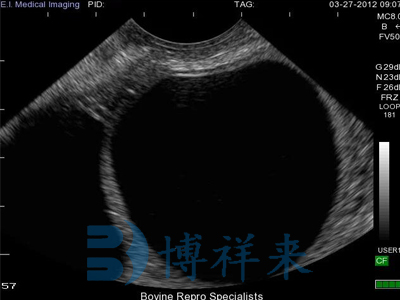Accurate diagnosis and treatment of ovarian cysts are important aspects of proper reproductive management in any dairy herd. Although the negative impact of ovarian cysts on the normal estrous cycle, prolonged intervals between conception and calving is evident; It may be difficult to determine which type of cyst is located in the ovary (follicle, corpus luteum, or even cystic corpus luteum). Each type of diagnosis is important because the correct treatment methods for follicles and corpus luteum cysts are different, and using a cow ultrasound machine is the best tool to achieve this goal. Let's describe each type of ovarian cyst and describe the benefits of ultrasound diagnosis for them.
Imaging of bovine follicular cyst on cow B-ultrasound machine
When the follicle reaches ovulation size (about 17 to 19 millimeters), a follicular cyst occurs in cows, but the egg cannot ovulate, leaving large persistent follicular structures on the ovary. A single follicular cyst or multiple cysts can form on the ovary. The duration of ovarian follicles before they are considered follicular cysts is usually at least 10 days. There are various classifications of 'true follicular cysts', but the classic identifying feature is the follicular structure on the ovary, which is at least 25mm in size without any corpus luteum. Using a cow ultrasound machine, the appearance of follicular cysts can be clearly seen, with large cystic structures having very thin outer walls and black fluid extending to their outer edges, as shown in the following figure.
As you can see, using a cow ultrasound machine can clearly diagnose this type of cyst and the presence of a second follicular cyst can also be seen on the left side of the ovary. Rectal palpation makes it very easy for these cysts to rupture, which can cause trauma to the ovaries, lead to bleeding, and may form adhesions on the ovaries. The less invasive method of using a cow ultrasound machine can reduce the chance of follicular cyst rupture and is very effective in determining whether the cyst is active or benign. When there is a cyst, it is very difficult to touch any other structures on the ovary, so often there is no active corpus luteum found on the ovary together with the cyst. The following shows an example where a cyst is very prominent on the left side of the ovary, but can be classified as benign because the corpus luteum is located on its right side.
Although the etiology of follicular cysts is not yet clear, their development is related to genetics, malnutrition or overfeeding, high milk production (increased steroid metabolism), and stress. However, the main theory on how the above factors may lead to the formation of follicular cysts. Ovulation follicles begin to produce large amounts of estradiol, which targets the hypothalamus of the brain and triggers the initial cascade to induce ovulation. People believe that this cascade reaction is poor, inhibiting ovulation leads to the persistence of follicles and the development of follicular cysts. Hormone therapy with GnRH (also known as human chorionic gonadotropin) for follicular cysts typically causes luteinization of the cyst, followed by treatment with follicle stimulating hormone F2 alpha to resolve the cyst by triggering luteal lysis.

Imaging of Luteal Cyst on Cow B-ultrasound Machine
Luteal cysts are believed to develop from follicular cysts, which continue to progress to their later stages. They usually enter the corpus luteum cyst by forming a thicker corpus luteum tissue wall around its outer edge, as shown in the following figure. You can also see a little white "spider web" inside the cavity of the corpus luteum cyst, where the cyst seems to be attempting to further promote luteinization.
For corpus luteum cysts originating from follicular cysts, the same mechanism exists for the development of follicular cysts as described above. The main distinguishing factor between the two is partial luteinization of the corpus luteum cyst. According to the rate of luteinization, luteal cysts in cows can also have different appearances on ultrasound machines. This is evident in the two figures below, depicting more examples of corpus luteum cysts. You can see in the * * * picture that luteinization occurs along the lower edge of the cyst, and the spider web of fibrous tissue tries again to luteinize the rest of the cyst, but the upper part of the lumen is still filled with fluid.
The second image is the early stage of a corpus luteum cyst (located on the right side of the ovary), where the thin outer wall of the cyst still resembles a follicular cyst, but when the cyst attempts to promote luteinization, spider webs are evident throughout the cavity. You can also see a second cyst on the left side of the ovary.
One major advantage of using a B-ultrasound machine to treat these cysts in cows is its ability to distinguish between corpus luteum cysts and very young corpora lutea (on the 5th or 6th day of the estrus cycle). The early corpus luteum will also have fluid filled lumens and spider webs as it continues to undergo luteinization. It is very difficult to palpate the early corpus luteum using rectal palpation, let alone distinguish it from corpus luteum cysts, as they all have similar palpable features but can be more clearly distinguished by ultrasound. The following describes the early corpus luteum, and you can see the difficulty in distinguishing between palpable corpus luteum cysts.
Due to the fact that luteal cysts always have luteal tissue and produce progesterone, the best way to address them is to administer luteinizing hormone F2 alpha to induce luteal dissolution. Due to the fact that some early luteal cysts have not yet responded to gonadotropin F2 alpha, another approach includes first treating with GnRH and then treating with gonadotropin F2 alpha to further luteinize the cyst with GnRH, and then administering gonadotropin F2 alpha to address it.






